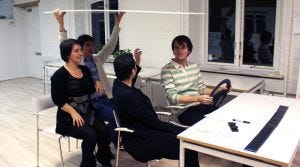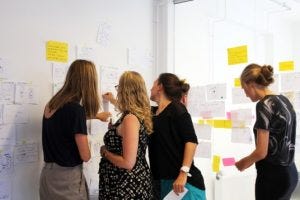The Rules of Good Collaboration
As our industry evolves from relying on manufacturing to being more heavily service-based, the role of a designer is evolving away from that of a ‘rockstar’, one-man genius. Here are CIID’s key principles for managing teams of collaborative fusionists that excel at designing services across our modern, complex systems.
The demand for good service experiences is equally as important as the desire for beautifully crafted and well manufactured objects. Because services are comprised of many interaction points over time, and are generally complex in nature, you can no longer rely on a single ‘rockstar’ designer to invent and design them.
You need a cross disciplinary team that can approach a challenge holistically and from multiple perspectives. This requires collaboration across perspectives and collective respect for the nuances of factors outside one’s individual expertise. This shift in role is not only benefitting our society and economy, but it is also creating an influx of designers who can work collaboratively to solve tough problems.
Over the years of leading design teams, we have captured what we believe are key principles for managing teams that are happy, productive, and embrace collaboration.





1. Do Research And Involve Everyone
Conducting research with your potential customers or users is key to creating internal team alignment. It not only informs your design process and makes sure you are addressing genuine needs and desires, but it also creates a shared vision for whom you are designing, and why.
When a team has a shared experience of meeting the people they are designing for, they instantly have a shared reference point. You eliminate the tendency to design for yourself or make a decision because ‘I would like this’. You remove bias and have a clear profile of the people you are aiming to help. From a practical point of view, the whole team doesn’t need to be research experts or lead research sessions, they just need to be involved in the process.
2. Formalise Reflection And Feedback Moments
It it important to structure reflection and feedback moments throughout a project. It allows the team to set expectations, it enables team development and transparency, and it encourages good team morale. Below are the key moments to factor in throughout a typical project.
Internal Kick-Off Workshop
Asides from clarifying project roles and responsibilities, an internal kick-off is a great opportunity for individuals to articulate where they would like to develop during the project and the skills they would like to strengthen. It allows team members to express what is important to them for the project and any hopes and fears they have.This could range from practicalities like ‘I have a Tuesday yoga class I need to leave early for’ to ‘let’s really push prototyping during the project’. It also means that the team isn’t catapulted into a project. There is ramp up and team building, which is especially crucial for newly formed teams.
Daily Stand-Ups
Host a daily stand-up meeting every morning. It is a great way to start the day. It allows the team to talk briefly about what they are working on that day, what their goals are, and if they need any help. It’s not about content at this point — it’s about giving everyone a clear overview of the project progress and identifying any issues that need to be addressed. Stand-ups should be short and focused. No computers. No distractions.
Design Reviews
Where possible have regular review sessions. Everyday if possible. Period design reviews minimise the danger of ‘a grand reveal’ and get teams comfortable showing work that is in progress and talking through their decision making process. It provides an outlet for design feedback, encouragement and it ensures that any separate work streams are aligned. They are also inspiring!
Project De-Brief & Dinner
At the end of a project have a team de-brief. Discuss what the challenges and successes were, and identify any recommendations for future projects. It’s often a good idea to get someone who hasn’t been directly involved in the project to facilitate. If you work in an agency, it is also useful to consider a client de-brief. Usually this works well as a meeting between both project leads (agency and client). Again, it’s an opportunity to talk about what did or didn’t work, and how to keep growing your relationship. It’s then the responsibility of the Project Lead to communicate the feedback back to the team.
At the end of a project it’s also very important to appreciate the hard work you have put in. Go for dinner, drinks, karaoke, what ever floats your boat. The important thing is to spend time as a team outside of the studio and give yourself a pat on the back.
3. Lead By Example, Stay Humble (this one’s for the leaders)
If you are a project leader/manager/director, it sounds obvious but you need to lead by example. Your role is to provide the platform and support for your amazing team to flourish and do great work. The most important factor is to stay humble. Egos are disruptive and there is a fine line between a being an assertive leader with creative confidence and a fully fledged ego. Lets be honest, if you have an ego, people either won’t want to work with you, or even worse they will begin to mirror you — and a bunch of egos in one room is an absolute collaboration killer.
4. Evolve Your Space
Your physical space should reflect the culture you are trying to promote and your way of working. If you want to work collaboratively, your space should enable teamwork and transparency; big desks you can all sit round, wall space/boards to present your work on, whiteboards to live sketch on. It is also important to adjust your space as you progress through a project. As you move through project phases, document and clear away material that is no longer needed. It’s important to have inspirational content around you, but not be overloaded with material.
This post was originally published on 13 January, 2016 by CIID Consulting.
The Copenhagen Institute of Interaction Design is a platform for enabling impact through innovation. With a commitment to disruptive thinking and action, people from all over the world congregate at CIID to work on or study innovation processes driven by prototyping and learning by doing. Since its inception in 2006, the talented and passionate people at CIID have been designing for empowerment and value creation for individuals, organizations, and society at large. The organization today includes an education program, a start-up incubator, and an Innovation Studio working with global brands around the world.
Early-bird tickets at a reduced price are now on sale for CIID: Service Design Through Experience Prototyping. In this intensive 3-day workshop from May 13–15, 2017, you will learn and apply advanced service design and experience prototyping techniques both in the digital and physical realm. You’ll also walk away equipped with a complete toolkit for rapid user-focused innovation and a certificate from CIID.
Get them as quickly as you can here.
facebook page: https://www.facebook.com/CIID.dk/
twitter: https://twitter.com/CIIDnews
Recent Posts
- How we assisted a prominent jewellery brand in India to enhance customer experience by streamlining billing processes and reducing turnaround time.
- How we developed an acceleration program involving internal teams for India’s largest food and beverage company.
- How we supported a multinational energy and petroleum company to promote a culture of customer centricity across various functions.
- How we empowered high-potential executives at a Swiss manufacturer of escalators, moving walkways, and elevators to leverage design thinking methodologies in crafting innovative products and services.
- How we guided Indian employees of an American pharmaceutical company to adopt the practice of identifying precise problem statements before delving into solution mode.